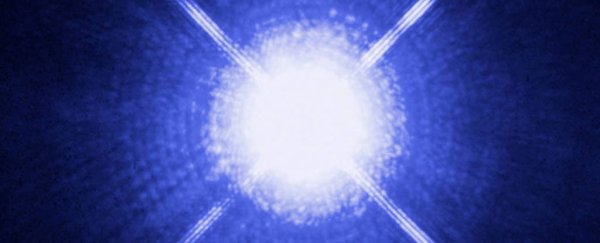Sirius, a double-star system and the brightest object in the night sky, will briefly blink out of existence for parts of Earth on Monday evening.
In an event called an occultation – when one object in space blocks the light of another behind it – a small asteroid known as (4388) Jürgenstock will slip in front of the star for a fraction of a second and, like an eclipse, cause it to briefly dim or even disappear.
"This unusual occultation of the brightest star in the night sky will occur around 10:30 p.m. MST on Monday evening, February 18," according to a post by Bill Merline from the Southwest Research Institute and David Dunham from KinetX Aerospace, which was published on the astronomer-run website Occultation Pages.
Here's where you can see asteroid Jürgenstock's occultation of Sirius, and how your watching the event could actually help astronomers.
Where and at what time to see Sirius blink out
 (Tomruen/Wikimedia Commons CC BY-SA 4.0)
(Tomruen/Wikimedia Commons CC BY-SA 4.0)
To understand where and when the occultation will be visible, it's helpful to think of a moving ball blocking a lightbulb, which would draw a moving shadow across a wall.
Another appropriate comparison is a solar eclipse, when the moon blocks the light of the Sun.
In the same way, Jürgenstock – a 3.1-mile-wide asteroid – will fly in front of Sirius and block some of its light. That will make a small, fuzzy shadow across Earth over the course of 21 minutes.
 (BREIT IDEAS Observatory/Google Maps)
(BREIT IDEAS Observatory/Google Maps)
That shadow of occultation, which we first learned about from Sky & Telescope, will begin in Antarctica, swing around the southern continent, then head north across the Southern Ocean and Pacific Ocean.
After Antarctica, the first land site to see the occultation should be the southern tip of Baja California in Mexico, at around 10:28 p.m. MST.
Next up will be the US cities of Las Cruces, New Mexico, and El Paso, Texas. Those southern locations will have a shot at viewing the event around 10:30 p.m. MST.
Then, around 10:31 p.m. MST (11:31 p.m. CST), Denver, Colorado, and parts of western Nebraska will get a chance to see it.
A series of maps created by Merline and Dunham shows exactly where stargazers can try to see the event, weather permitting.
The map below shows the general path and timing of visibility in Central America and North America.
The astronomers note that their predictions, while precise, aren't perfect. Sirius is too bright for spacecraft to determine its exact motion through and position in space, so the map shows a range of probable visibility stretching about 130 miles wide. Even at the central line, there is only a 7% chance of seeing a full Sirus-dimming occultation.
"If you are the lucky one to have the path go over your location, the star will fade over a period of several tenths of a second, probably will not disappear completely, and then will recover its full brightness over another several tenths of a second," the astronomers wrote.
"But it could be a shallow drop in brightness lasting perhaps only half a second, if you are near the edge of the path."
In the same way, Jürgenstock – a 3.1-mile-wide asteroid – will fly in front of Sirius and block some of its light. That will make a small, fuzzy shadow across Earth over the course of 21 minutes.
 (W. Merline, D. Dunham/Occultation Pages)
(W. Merline, D. Dunham/Occultation Pages)
If you plan to try to see the occultation, Merline and Dunham recommend reading up on the basics of how to view such an event at the International Occultation Timing Association.
For their part, Merline and Dunham plan to head to Las Cruces for a first US-based glimpse – and they are asking for anyone and everyone's help in seeing the event.
"If the occultation is actually observed, that could be valuable, to pin down Sirius's position to much better accuracy than we currently know it," they said.
If you are willing to help, read the astronomers' full instructions in their post about the occultation.
This article was originally published by Business Insider.
More from Business Insider:
